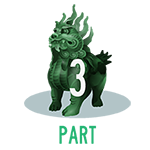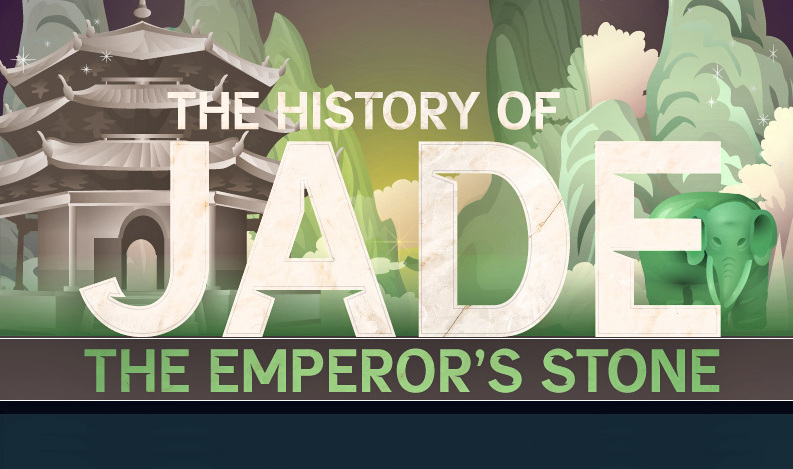Mining
The History of Jade: The Emperor’s Stone







The History of Jade: The Emperor’s Stone
Infographic presented by Electra Stone
In Chinese writing, it is no accident that the character for “emperor” looks almost identical to the character for “jade”.
In the West, precious gems such as diamonds or rubies were worn by high-ranking people as status symbols. However, in China, it is jade that has been a symbol of status, spirituality, purity, and health for over 9,000 years.
The Origins of Jade
Jade has been mined and worked in China since the Stone Age. In prehistoric sites, jade artifacts include simple ornaments with bead, button, and tubular shapes. It was also used for tools and weapons. Jade later became revered with special significance. Beautiful designs were used for carvings, decorations, ceremonies, furnishings, and jewelry for the Imperial families.
By 3,000 BC, jade became known as “yu” or the “royal gem”.
Xu Shen, from the Han Dynasty (206 BC to 221 AD), details the five virtues of jade in his work Shuowen Jiezi:
Benevolence for its lustre and brilliance.
Honesty for its translucent texture.
Wisdom for its tranquil and far-reaching tone.
Integrity and Bravery for it may be broken but cannot be twisted.
The most wealthy and influential members of society would be buried in jade suits. Extremely costly and taking years to assemble, the thread used to join the pieces of jade would be gold, silver, copper, silk, or other materials depending on the status of the person buried.
The first archaeological discoveries of these suits, of Prince Liu Sheng and Dou Wan of the Western Han dynasty, consisted of: 2498 pieces of jade and 2.5 lbs of gold wire.
The gemstone’s significance to Chinese culture cannot be understated. Entire kingdoms in China have started wars over particularly precious stones.
What is Jade?
Jade is different than other types of valuable gems or precious metals. In fact, the cultural term “jade” refers to two different and similar types of ornamental rocks, both made of different silicate minerals.
Nephrite jade was the very first of these materials discovered in China, and was the traditional jade used and carved since ancient times. Nephrite was so important that the traditional deposits in China are now all but depleted.
There is evidence that jadeite jade, coming primarily from Burma, began to be traded in China on a wider scale in the 14th century. It was harder, denser, and worked easier – it eventually became the form of the gemstone preferred by Chinese artisans and prized by the Chinese people.
Today, most jade traded in China is of the jadeite variety.
However, the country’s traditional nephrite jade is not forgotten. Every athlete’s medal, at the 2008 Beijing Olympics, was embedded with a piece of pure, natural-carved jade. The gold medal featured a rare form of white nephrite known as “mutton fat” jade.
The Value of Jade
Gold has a price; jade is priceless (Chinese proverb)
Jade is valued differently than other comparable gemstones or precious metals. Jade is not fungible like gold, and jade is not a single polished and cut crystal, such as in the case of diamonds or rubies.
Both jadeite and nephrite jade are stones formed of interlocking microcrystals. Jade comes in different shapes and sizes, and can have impurities or grains in the stone that define its character. This means each piece of jade is unique.
Professional craftsmen look at raw jade’s beauty, flaws, and spirit to determine what shall be carved from it. This potential ties into the price that people are willing to pay for it.
Jade jewelry and artwork are extremely important to China’s culture and history.
This is why buyers are willing to pay a steep price for the finest jade. What does the best jade sell for in China? It sells for the same price per carat as diamonds in the United States.
Lithium
Ranked: The Top 10 EV Battery Manufacturers in 2023
Asia dominates this ranking of the world’s largest EV battery manufacturers in 2023.

The Top 10 EV Battery Manufacturers in 2023
This was originally posted on our Voronoi app. Download the app for free on iOS or Android and discover incredible data-driven charts from a variety of trusted sources.
Despite efforts from the U.S. and EU to secure local domestic supply, all major EV battery manufacturers remain based in Asia.
In this graphic we rank the top 10 EV battery manufacturers by total battery deployment (measured in megawatt-hours) in 2023. The data is from EV Volumes.
Chinese Dominance
Contemporary Amperex Technology Co. Limited (CATL) has swiftly risen in less than a decade to claim the title of the largest global battery group.
The Chinese company now has a 34% share of the market and supplies batteries to a range of made-in-China vehicles, including the Tesla Model Y, SAIC’s MG4/Mulan, and various Li Auto models.
| Company | Country | 2023 Production (megawatt-hour) | Share of Total Production |
|---|---|---|---|
| CATL | 🇨🇳 China | 242,700 | 34% |
| BYD | 🇨🇳 China | 115,917 | 16% |
| LG Energy Solution | 🇰🇷 Korea | 108,487 | 15% |
| Panasonic | 🇯🇵 Japan | 56,560 | 8% |
| SK On | 🇰🇷 Korea | 40,711 | 6% |
| Samsung SDI | 🇰🇷 Korea | 35,703 | 5% |
| CALB | 🇨🇳 China | 23,493 | 3% |
| Farasis Energy | 🇨🇳 China | 16,527 | 2% |
| Envision AESC | 🇨🇳 China | 8,342 | 1% |
| Sunwoda | 🇨🇳 China | 6,979 | 1% |
| Other | - | 56,040 | 8% |
In 2023, BYD surpassed LG Energy Solution to claim second place. This was driven by demand from its own models and growth in third-party deals, including providing batteries for the made-in-Germany Tesla Model Y, Toyota bZ3, Changan UNI-V, Venucia V-Online, as well as several Haval and FAW models.
The top three battery makers (CATL, BYD, LG) collectively account for two-thirds (66%) of total battery deployment.
Once a leader in the EV battery business, Panasonic now holds the fourth position with an 8% market share, down from 9% last year. With its main client, Tesla, now sourcing batteries from multiple suppliers, the Japanese battery maker seems to be losing its competitive edge in the industry.
Overall, the global EV battery market size is projected to grow from $49 billion in 2022 to $98 billion by 2029, according to Fortune Business Insights.
-

 Markets1 week ago
Markets1 week agoU.S. Debt Interest Payments Reach $1 Trillion
-

 Business2 weeks ago
Business2 weeks agoCharted: Big Four Market Share by S&P 500 Audits
-

 Markets2 weeks ago
Markets2 weeks agoRanked: The Most Valuable Housing Markets in America
-

 Money2 weeks ago
Money2 weeks agoWhich States Have the Highest Minimum Wage in America?
-

 AI2 weeks ago
AI2 weeks agoRanked: Semiconductor Companies by Industry Revenue Share
-

 Markets2 weeks ago
Markets2 weeks agoRanked: The World’s Top Flight Routes, by Revenue
-

 Countries2 weeks ago
Countries2 weeks agoPopulation Projections: The World’s 6 Largest Countries in 2075
-

 Markets2 weeks ago
Markets2 weeks agoThe Top 10 States by Real GDP Growth in 2023













